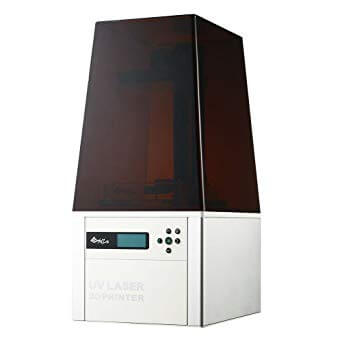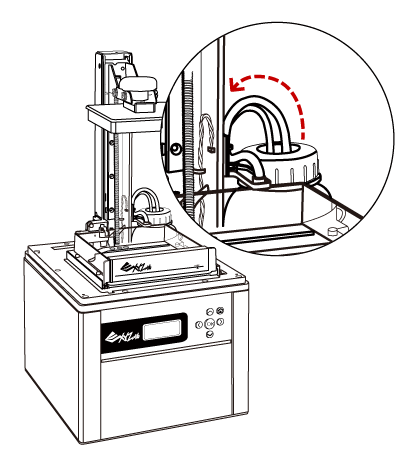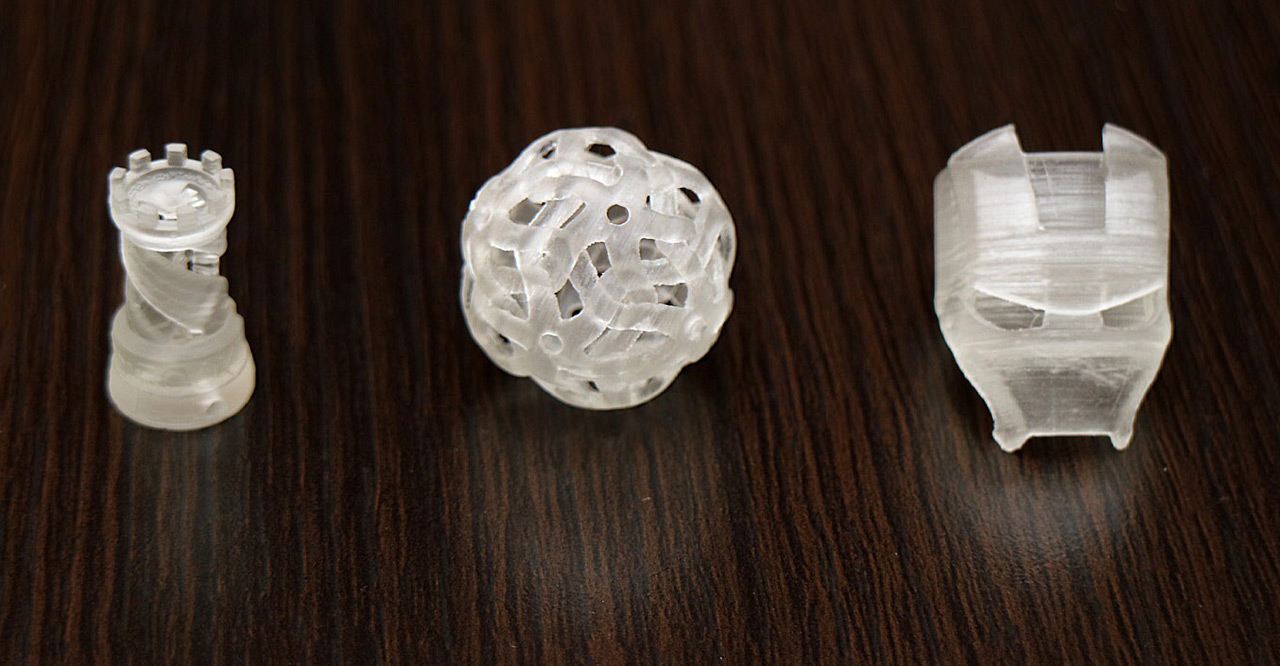|
Nobel 1.0 is an SLA printer that is available for a much cheaper price than most of the 3D printers in its category.
This 3D printer does have many benefits and has helped make SLA printing accessible for commercial use, however, it does have some limitations.
The Nobel 1.0 produces detailed designs and can be easily set up after taking out of the box. But the related cost of material and other pre-requisites, make it unsuitable for home use.
Here is a detailed review of Nobel 1.0. Check out the things you can do using this device and what to expect in terms of quality and speed.

Features
There are many great features and a few which could have been worked a bit better.
The best part about Nobel 1.0 is that one does not require to fill the tray with resin manually which is the case with most of the SLA printers.
The company has introduced a mechanism that pumps the required amount of liquid resin inside the tray as per the printing requirement.
While XYZPrinting has provided an automatic mechanism to pump the resin to the tray when 3D printing is on, switching resins isn’t that easy.
If you want to switch the resin or won’t be using the printer for some time, you must drain the autofill system. Moreover, the tray must be cleaned so that there is no chance for the resin to set on it.
The resin must be disposed of and should not be used for the next use. This makes it difficult to work with the material whenever there is a need for a change of resin.
Specifications
Before commenting on the size of the parts one can 3D print using Nobel 1.0. it is important to set the right expectation.
We are reviewing an SLA 3D printer and most of the SLA 3D printers are designed to print small volume parts.
Unlike their opposite 3D printing processes which can create large objects, SLA printers are sufficed with small prints.
| Specifications | |
|---|---|
|
Supported File Formats
|
.stl , XYZ Format (.3ws, .3wn) |
|
Max. Build Area (WxDxH)
|
5″ x 5″ x 7.9″ (128 x 128 x 200 mm ) |
|
Layer Resolution
|
25 / 50 / 100 microns |
|
Operating Temperature
|
18 ~ 28 °C / 64.4 ~ 82.4 °F
|
| Product Weight (without / incl. powder) |
9.6 kg (21.16 lbs) (500g resin bottle included)
|
Read the full specification list on their website.
Talking about Nobel 1.0, the device can print parts measuring 5 x 5 x 7.9 inches which combine for a total of 197.5 cubic inches.
This is a decent size to expect from an SLA 3D printer. Most of the competitors from the same family prints even less volume.
So, you get a good deal with the size of the part you can print with Nobel 1.0.
Price
The Nobel 1.0 costs around $1500. This may seem not too cheap when compared to many other FDM printers in the market.
However, comparing it with the price of other SLA printers, one would know why it’s called affordable. Moreover, the liquid resin is costly as well.
Those who have worked with FDM 3D printers may find everything too expensive.
Hence, it may not fit the budget of those wanting to 3D print for fun. Definitely, professionals can use it for giving shape to complex designs.
First Impressions
The design of Nobel 1.0 is simple yet beautiful. The sleek look with the plastic body makes it easy to carry from one place to another.
You can place it at any corner of your house. The 3D printer has a hood on the top.
This is an orange translucent plastic that helps block the UV rays used during the 3D printing process while still allowing users to see through the hood for checking the progress of the printing.

There is support beneath the hood that helps in holding the print bed. A motor is attached at the base of the print bed that allows it to move up and down during the 3D printing process.
The material, the liquid resin rests underneath the print head, stored in a tray. The UV layer penetrates through the clear bottom of the tray. After each layer solidifies, the print bed moves one layer up.
Setup
After taking the Nobel 1.0 SLA 3D printer out of the box, one must carry few steps before starting to 3D print.
The first step after unpacking the printer is to connect it with the electric source. Once the 3D printer is on, it would run a diagnostic test. This would take around 10 minutes.
Later, the print bed must be adjusted. For this, you may have to wait for some time until the bed lowers down. There are four screws provided with the printer which must be fixed around the print bed to hold it flat against the tray.
The other steps involve placing the resin bottle and connecting it with the auto-fill mechanism with the help of tubes provided.

These steps may sound difficult but aren’t. However, these are time-consuming and can take up more than an hour.
So, you may have to wait that long to test your first print. In case, you have experience setting up FDM printers, you would know that the SLA printer would take around twice the time consumed for setting up FDM ones.
One thing to note when working with Nobel 1.0 is that lifting a hood in any direction apart from straight-up when 3D printing completes can knock off the part or even the print bed.
There are many things to consider when 3D printing with Nobel 1.0. Hence, a detailed review would help further understand if the technology is for you or not.
Printing Type/Cost
The 3D printer is based on the SLA 3D printing process. While the printer is cheap when compared to other SLA variants, it is too costly against the price of FDM printers. The 3D printer costs $1499. What makes it more challenging is the cost of the material.
This may disappoint you a little to know that Nobel 1.0 is compatible only with resins that are offered by Nobel 1.0.
These resins are available in 500 ml bottles. The cost of two such bottles would cost around $119.
This is not as cheap as the plastic filament used with FDM printers. However, still cheap than most of the other resins used with other SLA printers.
The good part is that the material would last for long enough compensating the cost for spent on it.
Print Quality
SLA 3D printers are known for providing some best results when it comes to complex designs. And, Nobel 1.0 is no different.
This cute printer which can easily set around a corner can 3D print intricate designs with precision.
Although some layers may be visible on close examination, that is completely something one can overlook. You can print clean models using this printer.
Moreover, the curves can be realized perfectly with the help of this SLA 3D printer.
Talking about sculptures and geometrical shapes, you can expect it to deliver the best work.
Either it is about printing overhanging surfaces or clean and sharp corners, this printer would do a great job.
You may though find some inconsistencies in the parts obtained using the same model.

You will also need post-processing steps to get rid of the unsettled resins. For this, the company includes a scraper, a plastic tub, and a glove.
When the part is printed, use the glove to take out the bed and with the help of a scraper, remove the part from the print bed.
To get rid of the excess of resin that is not set yet, you must submerge the part in the alcohol. This is where the plastic tub and glove come handy.
However, the kit does not contain an alcohol bottle. You may get it from a drug store. Remember to buy anything more than 75% alcohol content.
Although the process is easy, you may find it a little messy. But who cares when you have the necessary tools to take care of that?
Software
The company provides XYZWareNobel, software to work with the designs. Here is one more limitation. The software is available for only windows PC but Mac users are not entertained.
This software works on the STL formats. You can move and scale the model using this software. Further, you can export the file for printing.
This software gets you the basic information about the printing process. It would tell you the time left to complete the print or the amount of resin left in the device.
Once the print is completed, you would require little post-processing steps to get the final part.
Customer Service
As you would expect, the XYZPrinting is great when it comes to taking care of the customers.
They have general FAQs on their websites with error codes and resolution. They do have chat support and online help.
Pros and Cons
The SLA 3D printer by Nobel 1.0, apart from all the pros and cons, has found its place among consumers.
The printer is backed by one of the best 3D printing processes and delivers decently based on the price.
- Can produce clean parts with complex geometry
- Needs less post-processing steps
- Printing is easy with Nobel 1.0
- Cheaper than most of the SLA printers
- Great for printing small parts with a detailed design requirement
- Layers are visible when checked closely
- Fine Details may be inconsistent
- Very slow when compared to other SLA printers
- Does not support Mac OS
- Limited material support
Factors Influencing Purchase Decision
3D Printer cost: If you are a beginner and want to try 3D printing, this may be an expensive option. Otherwise, getting an SLA printer for this cost is more than a treat for designers and artists.
3D Print quality: The print quality is decent when compared to other expensive SLA printers. However, better than many FDM ones and other variants.
3D Print speed: If you are expecting to print at a speed the FDM printers work, you have come to the wrong place. This 3D printer is slow. You can expect it to take more than 10 hours to print a 4.5-inch tinker model. If printed in high resolution, this may take more than a day to do the job. This example may give you an idea of what to look for when getting Nobel 1.0 installed at your place.
The speed is slower than most of the SLA 3D printers in the market. You may have to wait for hours when printing your parts.
3D Printer capability: This 3D printer can print a few of the most complex designs with ease. Sharp ends and rounded corners, all these specifications can be printed with detailed designs.
3D Printer Practicality: Specially designed for home use. The 3D printer is compact and with decent print quality can help many artists realize their work in front of their eyes. But not suitable for industrial use.
3D Printer User expectations: Getting an SLA 3D Printer at such a cheap rate may sound like a deal, but for high-end users, it may appear to be of no use. For those who want better quality for their models, it isn’t available with FDM printers who would love to use Nobel 1.0.
The Conclusion
Nobel 1.0 is a cheap SLA 3D printer. It has all the basic functionality to be considered one of the most accessible SLA printers for consumers with decent features.
The device can create great designs and is easy to work with. Alongside an easy printing mechanism, the printer does have many other qualities.
For example, it is compact and can be handled easily. Moreover, the plastic body makes it tough.
There are few limitations if you compare the printer with costly SLA 3D printers which may come for twice the price than what Nobel 1.0 is available for.
But what can you expect with the price tag you are paying to buy this printer? SLA printers do not come cheap.
The technology was once thought to be the technology for industrial use. With Nobel 1.0 and few other variants, SLA printers are now available for home use.
Not just that a great leap within the additive manufacturing ecosystem, it would open the door for learning and new possibilities.
If you have some serious goals and learning 3D printing is more than just a fun factor, you can choose Nobel 1.0. Learning to work with an SLA printer will certainly be a great addition to your skillset.









